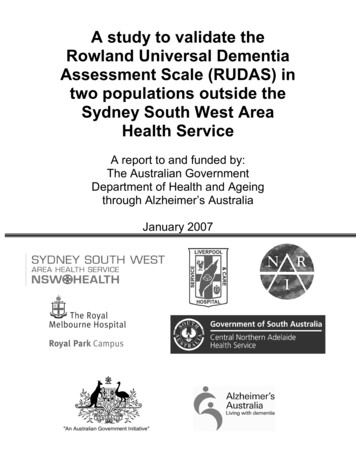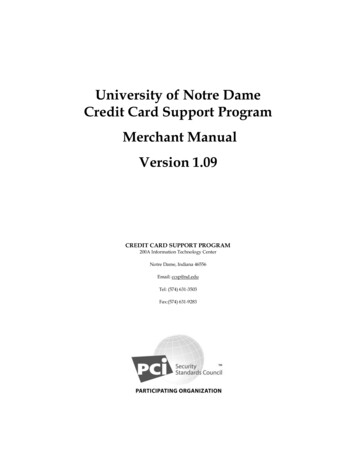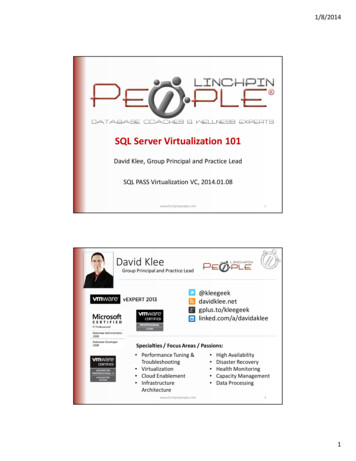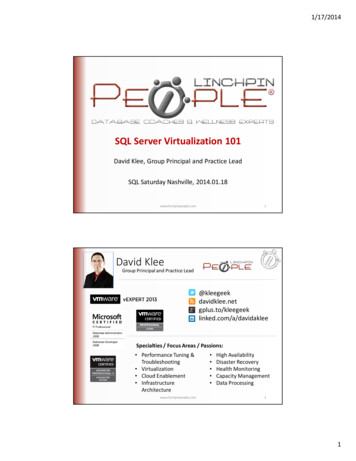
Transcription
A study to validate theRowland Universal DementiaAssessment Scale (RUDAS) intwo populations outside theSydney South West AreaHealth ServiceA report to and funded by:The Australian GovernmentDepartment of Health and Ageingthrough Alzheimer’s AustraliaJanuary 2007"An Australian Government Initiative"
Rowland J, Conforti D, Basic D, Vrantsidis F, Hill K, LoGiudice D, RussellM, Haralambous B, Prowse R , Harry J and Lucero K. 2006. A study toevaluate the Rowland Universal Dementia Assessment Scale (RUDAS) intwo populations outside of the Sydney South West Area Health Service.Report from South West Sydney Area Health Service and the NationalAgeing Research Institute to the Australian Government Department ofHealth and Ageing.This publication was supported by funding from the AustralianGovernment Department of Health and Ageing, under the NationalDementia Support Program. The opinions expressed in this documentare those of Alzheimer's Australia and not necessarily those of theAustralian Government.
Table of contentsList of Abbreviations. 3Acknowledgements . 4Partner Organisations . 51.0 EXECUTIVE SUMMARY . 71.1 Method . 71.2 Results . 71.3 Summary . 81B PLAIN LANGUAGE EXECUTIVE SUMMARY. 91B.1 Method . 91B.2 Results . 91B.3 Summary. 102.0 INTRODUCTION . 113.0 BACKGROUND . 134.0 METHODOLOGY. 144.1 Project rationale and aims . 144.2 Multicultural populations . 144.3 Participants. 144.4 Sample size / power calculations. 154.5 Ethics approval . 154.6 Recruitment and assessment process. 154.7 Measurements. 164.8 Statistical analyses . 174.9 Cognitive diagnoses and instrument cut points . 185.0 RESULTS . 205.1 Overall subject characteristics . 205.2 Comparison of cognitive impairment versus normal cognition groups. 205.3 Correlations between instruments . 275.4 Prediction accuracy of the cognitive screening tools . 285.4.1 Receiver Operating Characteristic curves . 285.4.2 Sensitivity/specificity analyses. 305.4.3 Likelihood ratios. 315.5 Effects of other covariates such as age, gender, education, CALDstatus, other performance factors, marital status and reading/writingstatus. 315.5.1 Age . 325.5.2 Gender . 325.5.3 Education . 325.5.4 Culturally and Linguistically Diverse (CALD) status. 325.5.5 Other performance factors. 335.5.6 Geriatric Depression Scale . 335.5.7 Marital status . 335.5.8 Reading / writing status . 345.5.9 Univariate and multiple logistic regression for cognitive screeningscores. 345.5.10 Summary . 356.0 DISCUSSION. 377.0 CONCLUSION . 40A study to validate the Rowland Universal Dementia Assessment Scale1
8.0 REFERENCES. 419.0 APPENDIX. 43A study to validate the Rowland Universal Dementia Assessment Scale2
List of Abbreviations95% CI95% Confidence IntervalABSAustralian Bureau of StatisticsACAPAged Care Assessment ProgramAUCArea Under the CurveCACPCommunity Aged Care PackagesCALDCulturally and Linguistically DiverseCDAMSCognitive, Dementia and Memory ServiceCDRClinical Dementia RatingCIConfidence IntervalCTSCommunity Therapy ServiceDSMIV - TRDiagnostic and Statistical Manual of Mental Disorders(Fourth Edition) (Text Revision)EACHExtended Aged Care at Home PackagesGDSGeriatric Depression ScaleGPGeneral PractitionerGPCOGGeneral Practitioners Assessment of CognitionIQRInterquartile rangeLIADLLawton Instrumental Activities of Daily LivingLRLikelihood ratioMBIModified Bathel IndexMMSEMini-Mental State ExaminationOROdds ratioRAHRoyal Adelaide HospitalRMHRoyal Melbourne HospitalROCReceiver Operating CharacteristicRUDASRowland Universal Dementia Assessment ScalerPearson r correlation co-efficientr2Correlation co-efficient squared, % variance explainedSDStandard deviationSDACSurvey of Disability, Ageing and CarersA study to validate the Rowland Universal Dementia Assessment Scale3
AcknowledgementsThe project teams would like to thank the following for their participation andsupport of the project: All the study participants Recruiting clinics and staff:Melbourne site: Cognitive, Dementia and Memory Services (Royal Melbourne Hospital–Royal Park Campus CDAMS and the Sunshine Hospital CDAMS), Falls and Balance Clinic and Community Therapy Service (RoyalMelbourne Hospital–Royal Park Campus).With particular thanks to: Royal Melbourne Hospital – Royal Park Campus CDAMS staff Ms Aileen Kalogeropoulos (Royal Park Campus CDAMS & Fallsand Balance Clinic) Dr Eric Seal (Royal Park Campus Falls and Balance Clinic andSunshine Hospital CDAMS)Adelaide site: Royal Adelaide Hospital Memory Service Day Rehabilitation Centre, Hampstead Centre, Royal Adelaide Hospital Ridleyton Greek Homes for the Aged & Italian Benevolent FoundationSA Inc (respite programs) Greek Orthodox Community of South AustraliaWith particular thanks to: Helena Kyriazopoulos, Alzheimer’s Australia (SA) Dr Jon Symon, Royal Adelaide Hospital Memory Service Dr Anna Chur-Hasen, University of AdelaideA study to validate the Rowland Universal Dementia Assessment Scale4
Partner OrganisationsLiverpool HospitalThe Liverpool Hospital has been operating continuously since the lateeighteenth century and in 1989 became a principal teaching hospital of theUniversity of N.S.W. Major redevelopment of the Hospital has taken placeand Stage 1 has been completed to upgrade all services to a tertiary level.These services include Aged Care, Cardiology, Coronary Care, Drug &Alcohol, Emergency Genetics, Gynaecology, Intensive Care, Mental HealthServices, Neonatology (New Born Care), Obstetrics, Orthopaedics, PaediatricServices, Pathology-Diagnostics, Allied Health, Public Health, Radiology,Renal Medicine (Nephrology), Sexual Assault Service, Sexually TransmittedDisease, General Surgery, Psychiatry, Outpatients. Stage 2 planning isnearing completion and the Liverpool hospital will double in size to have morethan a 1,000 beds by 2010. Improvements will include extension of theClinical Services Building, Cancer and Pathology services and new buildingsfor Women’s and Child Health and Aged Care Services. There will also be adedicated research building. The Department of Geriatric Medicine atLiverpool is responsible for inpatient care as well as a range of communitybased health services for older people. The research focus has beenmultidisciplinary, clinical based research into geriatric syndromes such as fallsprevention and the management of cognitive impairment. Other areas ofinterest have included the management of the older person in the EmergencyDepartment and inpatient setting, long term outcomes of service provision,liaison with general practitioners, improving end of life care and enhancedcommunication across the continuum of care.National Ageing Research InstituteThe National Ageing Research Institute (NARI) was established in 1994 asthe successor to the National Research Institute for Gerontology and GeriatricMedicine (NRIGGM). NRIGGM was formed in 1977 as the result of anagreement between Mount Royal Hospital (now Royal Melbourne Hospital Royal Park Campus), The University of Melbourne and the Government ofVictoria. NARI/NRIGGM has been providing leadership in research, programimplementation and training in the areas associated with improving health andquality of life for older people for nearly 30 years. NARI has developed as acentre of excellence in research on ageing, public health research, includinghealth service evaluation, and the delivery of quality aged care educationprograms for health professionals and service providers.Royal Melbourne Hospital – Royal Park CampusRoyal Melbourne Hospital – Royal Park Campus provides health careservices predominantly to older people who live in the northern and westernmetropolitan regions of Melbourne. Royal Melbourne Hospital – Royal ParkCampus aims to be a centre of excellence in the provision of aged care andrehabilitation services. There are around 150 in-patient beds at this campus,which are located in six wards, including three Geriatric Evaluation andA study to validate the Rowland Universal Dementia Assessment Scale5
Management (GEM) wards, a rehabilitation ward (primarily amputee andneurological patients), an Aged Transitional Care Unit, and a complexresidential care unit (caring for residents with acquired brain injuries). TheRoyal Park Campus acts as the base for Aged Care Assessment Services, acommunity rehabilitation centre, a day activities centre and CommunitySupport Services. It has specialist medical outpatient clinics which deal withpain, falls and balance, memory, continence and wounds.Royal Adelaide HospitalFounded in 1840 and incorporated under the South Australian HealthCommission Act, 1976, the Royal Adelaide Hospital (RAH) has threecampuses (North Terrace, Hampstead Rehabilitation Centre and StMargarets). The RAH provides more than 848 inpatient beds as well asassociated outpatient and outreach services. It also provides a specific rangeof tertiary referral services and a broad range of clinical services. The RAH isinvolved in numerous areas of medical and health research and is a majorteaching hospital for the University of Adelaide. It is also closely affiliated withthe Hanson Institute.A study to validate the Rowland Universal Dementia Assessment Scale6
1.0EXECUTIVE SUMMARYOver recent years there has been a recognised need for new cognitivescreening tools to be developed and validated that address identifiedlimitations of existing tools. Limitations have included that tools appear to beinfluenced by factors such as education level, cultural background andlanguage, and that some important aspects of cognitive function such asfrontal lobe function are not assessed. The Rowland Universal DementiaAssessment Scale (RUDAS) was developed to address some of theselimitations. Initial results published in 2004 reported high reliability and goodprediction accuracy for the RUDAS. A subsequent study in 2006 indicatedthe RUDAS compared favourably with a commonly used existing screeningtool (the Mini Mental State Examination - MMSE), and indicated that unlikethe MMSE the RUDAS did not appear to be influenced by language,education or gender. The next stage of the validation required evaluation ofthe RUDAS in a region external to the initial studies (southwest Sydney). Thisstage also needed to incorporate a sample with a broad range of cognitivefunction, including those with mild cognitive impairment.1.1 MethodFunding was provided by the Australian Government Department of Healthand Ageing through Alzheimer’s Australia to undertake the project. TheNational Ageing Research Institute coordinated recruitment in Melbourne, andthe Royal Adelaide Hospital and Alzheimer’s Australia SA coordinatedrecruitment in Adelaide. The primary aims of the project were to validate theRUDAS in other settings (Melbourne and Adelaide) and in a broader samplepopulation that included those with mild/moderate cognitive impairment. Asecondary aim of the project was to compare the RUDAS with two existingcognitive screening tools (the MMSE and the General PractitionersAssessment of Cognition – GPCOG) in its utility and ability to accuratelypredict cognitive impairment. Ethics Committee approval was obtained forthe project.One hundred and fifty one people met the study inclusion criteria andcompleted the assessment process. Participants completed a series ofcognitive assessments and measures of function and depression, in additionto the RUDAS, MMSE and GPCOG.1.2 ResultsUsing DSMIV-TR classification criteria, 40% of participants had normalcognition and 60% had some form of cognitive impairment. Based on theCognitive Dementia Rating scale, 90% of participants with cognitiveimpairment were classified as having questionable or mild cognitiveimpairment. Participants had an average age of 77 years (SD 8.9), 70% werefemale, and 42% were from Culturally and Linguistically Diverse (CALD)backgrounds. Median [Inter-quartile Range] scores for the full sample on theRUDAS was 23 [18-27], the MMSE 25 [19-28] and the GPCOG (two stageA study to validate the Rowland Universal Dementia Assessment Scale7
process) 7 [2-9]. All three cognitive screening tools were highly correlated(rho 0.78).Accuracy of prediction of cognitive impairment against the gold standard ofthe DSMIV classification was high for the three screening tools, and there wasno significant differences between the tools (RUDAS Area Under Curve –AUC 0.88, MMSE AUC 0.86, GPCOG AUC 0.90). The positive and negativelikelihood ratios of each tool were also similar (RUDAS 7.3 and 0.3respectively, MMSE 5.5 and 0.4 respectively, GPCOG 4.6 and 0.1respectively). Multifactorial logistic regression identified that each of the threecognitive screening tools was a significant predictor of cognitive status (basedon the DSMIV classification) after adjusting for other covariates. With RUDASin the multifactorial model, age and GDS score were additional significantpredictors of cognitive status. With MMSE in the multifactorial model, age,gender and GDS score were additional significant predictors of cognitivestatus. With GPCOG in the multifactorial model, age, gender and GDS scorewere once again found to be significant predictors of cognitive status. Inrelation to factors confounding the relationship between the cognitivescreening tests and cognitive status, the MMSE and GPCOG were bothinfluenced by confounding whereas the RUDAS was not influenced bysubstantial confounding. CALD status affected the MMSE score in predictingcognitive status and the GDS score affected the GPCOG score in predictingcognitive status.1.3 SummaryResults from this study provide further evidence to support the use of theRUDAS in screening people for cognitive impairment. In terms of the primaryaims of the project, the RUDAS was found to have high predictive accuracy ina broader population sample, that included other settings (Melbourne andAdelaide) and a range of cognitive function (including mild to moderatecognitive impairment). In terms of the secondary aim of the project, similarprediction accuracy between the RUDAS, MMSE and GPCOG wasdemonstrated. However, the RUDAS was not substantially affected(confounded) by other factors in predicting cognitive status, unlike the MMSE,where CALD status was a strong confounding factor, or the GPCOG, whereGDS was a strong confounding factor. The RUDAS has some advantages inits broad application, in that it does not require presence of an informant (incontrast to the GPCOG), and it does not include items that have potential tocause difficulties for some people with lower education levels or CALDbackground (in contrast to the MMSE).A study to validate the Rowland Universal Dementia Assessment Scale8
1BPLAIN LANGUAGE EXECUTIVE SUMMARYOver recent years there has been a recognised need for new cognitivescreening tools to be developed and validated that address identifiedlimitations of existing tools. Limitations have included that tools appear to beinfluenced by factors such as education level, cultural background andlanguage, and that some important aspects of cognitive function such asfrontal lobe function are not assessed. The Rowland Universal DementiaAssessment Scale (RUDAS) was developed to address some of theselimitations. Initial results published in 2004 reported high reliability and goodprediction accuracy for the RUDAS. A subsequent study in 2006 indicatedthe RUDAS compared favourably with a commonly used screening tool (theMini Mental State Examination - MMSE), and indicated that unlike the MMSEthe RUDAS did not appear to be influenced by language, education orgender. This project, funded by the Australian Government Department ofHealth and Ageing through Alzheimer’s Australia, involves a further stage ofvalidation for the RUDAS.1B.1 MethodThe National Ageing Research Institute coordinated recruitment in Melbourne,and the Royal Adelaide Hospital and Alzheimer’s Australia SA coordinatedrecruitment in Adelaide.The primary aim of the project was to validate the RUDAS in regions externalto the initial studies (southwest Sydney) and in a broader sample populationthat included those with mild/moderate cognitive impairment (as earlierstudies had samples with a high proportion of people with more severecognitive impairment). A secondary aim was to compare the RUDAS with twoexisting cognitive screening tools (the MMSE and the General PractitionersAssessment of Cognition – GPCOG) in its utility and ability to accuratelypredict cognitive impairment. Ethics Committee approval was obtained forthe project.One hundred and fifty one people met the study inclusion criteria andcompleted the assessment process. Participants completed a series ofcognitive assessments and measures of function and depression, in additionto the RUDAS, MMSE and GPCOG.1B.2 ResultsParticipants had an average age of 77 years, 70% were female, and 42%were from Culturally and Linguistically Diverse (CALD) backgrounds. Fortypercent of participants had normal cognition and 60% had some form ofcognitive impairment. Based on the Cognitive Dementia Rating scale, 90% ofparticipants with cognitive impairment were classified as having questionableor mild cognitive impairment. Average scores for the full sample on theRUDAS was 23, the MMSE 25, and the GPCOG (two stage process) 7. Allthree cognitive screening tools were highly correlated.A study to validate the Rowland Universal Dementia Assessment Scale9
All three screening tools demonstrated a high level of accuracy in prediction ofcognitive impairment against the gold standard classification (DSMIV –TRcriteria), and there was no significant differences between the tools. Inanalyses exploring the influence of a number of potential factors on theassociation between scores on the various tools and prediction of cognitiveimpairment, CALD status was shown to affect the MMSE score, and theparticipant’s depression score was shown to affect the GPCOG score.1B.3 SummaryResults from this study provide further evidence to support the use of theRUDAS in screening people for cognitive impairment. In terms of the primaryaims of the project, the RUDAS was found to have high predictive accuracy ina broader population sample, that included other settings (Melbourne andAdelaide) and a range of cognitive function (including mild to moderatecognitive impairment). In terms of the secondary aim of the project, similarprediction accuracy between the RUDAS, MMSE and GPCOG wasdemonstrated. However, the RUDAS was not substantially affected(confounded) by other factors in predicting cognitive status, whereas theMMSE and GPCOG were both influenced by other factors. The RUDAS hassome advantages in its broad application, in that it does not require presenceof an informant (in contrast to the GPCOG), and it does not include items thathave potential to cause difficulties for some people with lower education levelsor CALD background (in contrast to the MMSE).A study to validate the Rowland Universal Dementia Assessment Scale10
2.0INTRODUCTIONThe Australian population is rapidly ageing. Dementia disproportionatelyaffects the oldest age groups, causes considerable morbidity to patients andcarers, and generates large health-care costs. As treatment options fordementia evolve, the accurate and early detection of dementia will becomeeven more important.Older persons from culturally and linguistically diverse (CALD) backgroundsare particularly vulnerable to the difficulties associated with early and accuratediagnosis of dementia (Davis et al., 1996). It is suspected that people fromCALD backgrounds are more likely to be diagnosed later on in the process ofthe illness or to be misdiagnosed due to a number of factors. Some of thesefactors include communication difficulties, cultural misunderstandings andculturally inappropriate tools (Black et al., 2001).At a national level in 1996, 17.8% of the Australian population were bornoverseas in a country that is culturally diverse and where English is not themain spoken language. This figure is projected to increase to 21.2% in 2026(Australian Institute of Health and Welfare, 2001). This is an important andgrowing portion of the Australian population. In addition, approximately 12.4%of Australians with dementia do not speak English at home (AccessEconomics; 2006).To be widely applicable, neuropsychological tests must be responsive tocultural and linguistic diversity, education, literacy and degree of acculturation(the exchange of cultural features which result when groups come intocontinuous direct contact). This is important to ensure that treatments, suchas new medications, psychological interventions and support services, aretargeted to those most in need in a timely manner.Currently, one of the most widely used cognitive screening tests is theFolstein Mini-Mental State Examination (MMSE), which has been in use foralmost 30 years. It is recommended by the American Academy of Neurologyand others for early detection of dementia (Petersen et al., 2001), and inAustralia is commonly used to determine eligibility for subsidised medicationfor Alzheimer’s disease. The MMSE was developed in an English-speakingpopulation, with versions in other languages mostly using direct translationrather than culturally specific adaptation. However, phrases such as “no ifs,ands or buts” are not easily translated, and items such as “spell WORLDbackwards” and “serial 7s” may be less relevant to people from somecultures. MMSE scores are influenced by age, education, ethnicity andlanguage of the interview (Escobar et al., 1986). Many older persons fromculturally and linguistically diverse countries have low levels of education andspeak little English, and therefore decisions based on the MMSE may bemisleading. Furthermore, the MMSE is limited in its detection of frontal lobeimpairment (Royall et al., 1994; Slachevsky et al., 2004).A study to validate the Rowland Universal Dementia Assessment Scale11
A more recently developed screening test for dementia, designed for generalpractice, is the General Practitioner Assessment of Cognition (GPCOG). Itconsists of cognitive test items and historical questions asked of an informant,and compares favourably with the MMSE (Brodaty et al., 2002). Unlike theRUDAS, however, the need for an informant may be a limitation of the tool forthose patients who do not have a carer/informant.The RUDAS has been developed to address some of these limitations ofexisting cognitive screening tools such as the MMSE and GPCOG. It doesnot appear to be influenced by language or education, and earlier worksuggests that all items can be directly translated to other languages, withoutthe need to change the structure or the format of any item. Several itemsaddress frontal lobe impairment, and the diverse response formats allow morecomprehensive assessment of overall cognition (Storey et al., 2004).Some of the potential benefits of the RUDAS include:1. Improved equity in health-care for CALD persons through targetedscreening and earlier and more accurate identification of dementia;2. Improved general practitioner’s ability to diagnose dementia, beginappropriate assessment and referral, monitor the progress of the diseaseand provide ongoing management. Early detection of dementia willbenefit those with cerebrovascular disease, for which there are effectivetreatments, as well as those with reversible conditions causing cognitiveimpairment. In addition, most drugs recommended for Alzheimer’sdisease are most useful during the mild to moderate stages of the disease;3. Improved access to support services and treatment, including eligibility forsubsidised medication through earlier identification of dementia. Thisshould help both the client and carer and may prevent or delay institutionalcare;4. Identification of frontal lobe dysfunction, unlike the widely used MMSEwhich is often normal in subjects with dementia predominantly affectingthe frontal lobes;5. Provides an objective measure of cognitive status that does not rely onhistory from an informant. A moderate proportion of persons withdementia do not have a carer/informant1 (AIHW; 2006);6. The RUDAS is also easy to administer (only 10 minutes), requires minimaltraining to administer (40 minutes) and is easily translated into over 30different languages; and7. The RUDAS also appears to be less confronting to recipients.1. Based on ABS 2003 Survey of Disability, Ageing and Carers (SDAC) data for clients ofACAP (Aged Care Assessment Program), CACP (Community Aged Care Packages) andEACH (Extended Aged Care at Home Packages) programs who had dementia and wereliving in households (not residential care), on average 13.5% did not have a carer (ACAP 12%, CACP 26.2% and EACH 3.3%). The 2003 SDAC data however tends to identifythose with severe and profound disability.A study to validate the Rowland Universal Dementia Assessment Scale12
3.0BACKGROUNDThe Rowland Universal Dementia Assessment Scale was developed andvalidated in the southwest of Sydney by a team at the Liverpool Hospital. Theoriginal study by Storey et al (2004) involved three stages - thedevelopmental stage, the clinical testing of the 42 ‘culturally fair’ cognitiveitems developed, and the assessment of the predictive accuracy of the final 6item RUDAS. In the predictive accuracy stage, involving a sample of 90community dwelling older people, the RUDAS was found to: assess multiple cognitive domains, including frontal lobe impairment; have high inter-rater (0.99) and test/retest (0.98) reliability; have high sensitivity (89%) and high specificity (98%) and the areaunder the Receiver Operating Characteristic (ROC) curve was 0.94(95% CI 0.87 – 0.98); and not be influenced by gender, years of education, differentialperformance factors and preferred language.In a follow-up study by Rowland et al (2006), involving 129 communitydwelling persons randomly selected from a database of referrals to an agedcare team, the RUDAS was compared to the Folstein Mini-Mental StateExamination (MMSE). The authors found that the RUDAS was at least asaccurate as the MMSE in diagnosing dementia. The area under the ROCcurve (AUC) for the RUDAS was 0.92 (95% CI 0.85-0.96) and 0.91 (95% CI0.84-0.95) for the MMSE. Published cut points were used for each instrument(RUDAS 23/30; MMSE 25/30). The positive and negative likelihood ratiosfor the RUDAS were 19.4 and 0.2 respectively compared to 2.1 and 0.14 forthe MMSE. The high positive likelihood ratio for the RUDAS makes itparticularly useful for ruling-in disease. That is, at the recommended cut point( 23), there is a strong likelihood that cognitive impairment is in fact present.This study also reconfirmed that the RUDAS does not appe
Department and inpatient setting, long term outcomes of service provision, liaison with general practitioners, improving end of life care and enhanced communication across the continuum of care. National Ageing Research Institute The National Ageing Research Institute (NARI) was established in 1994 as











